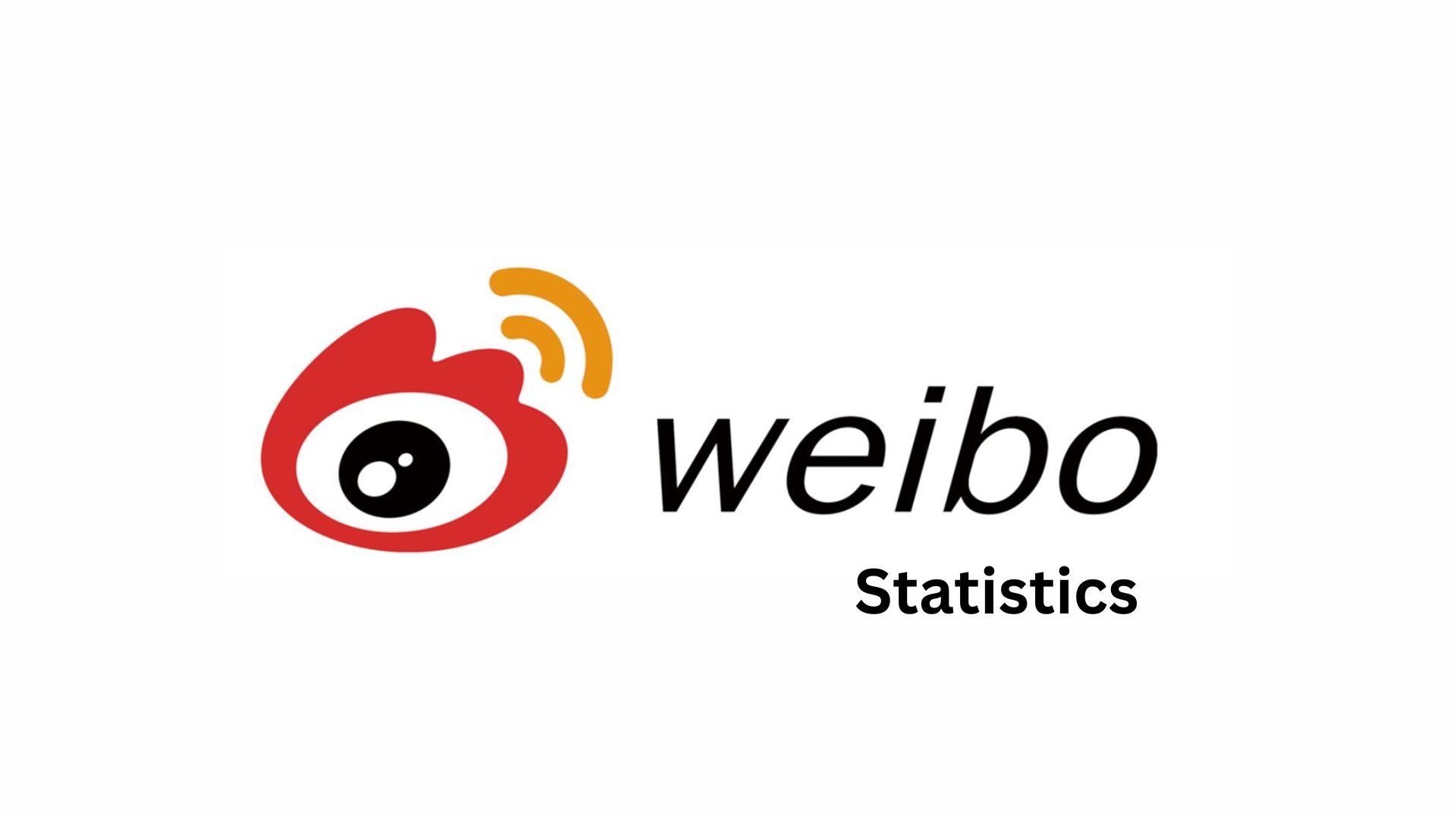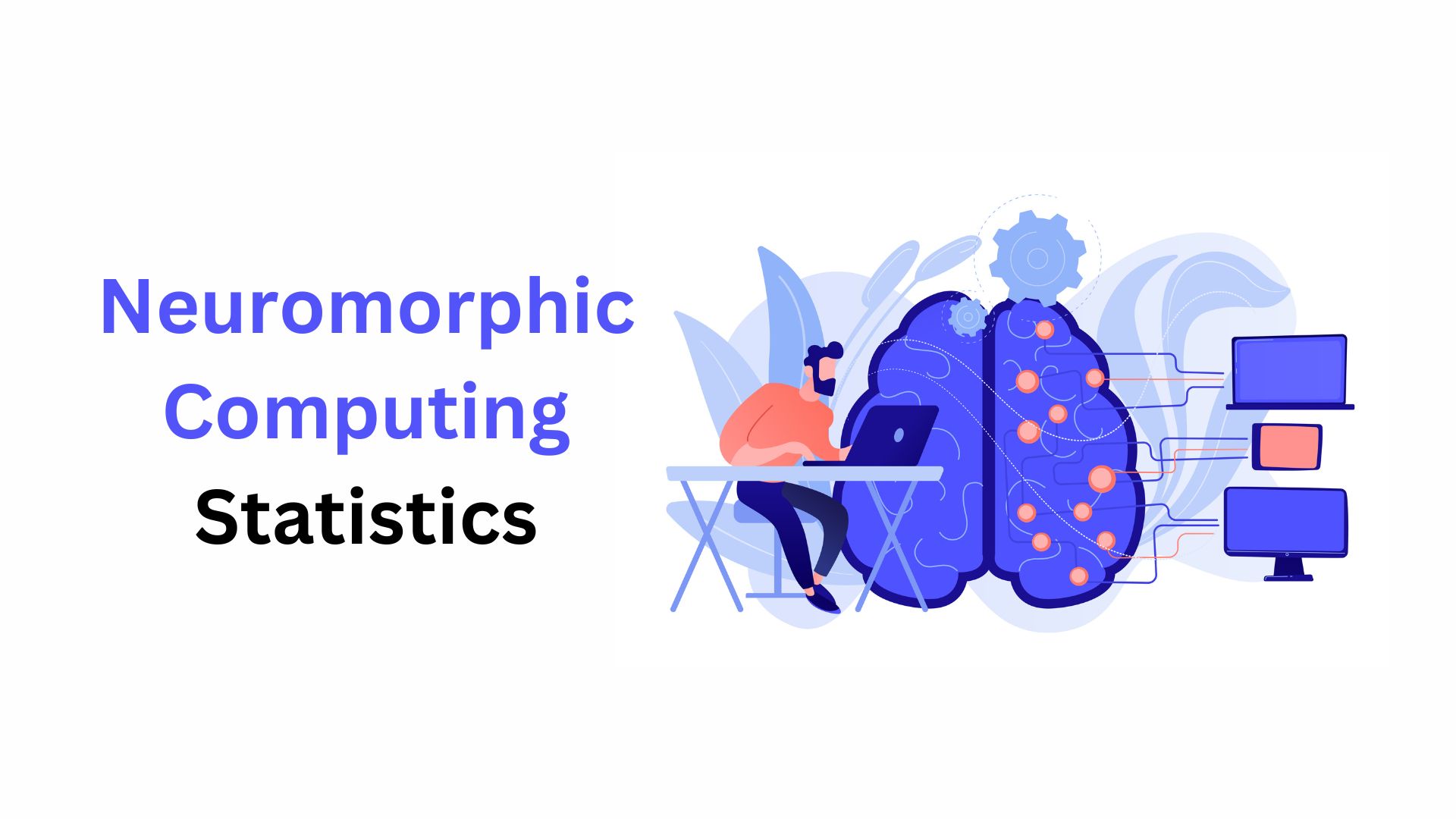Business Innovation Statistics By Sector, AI Adoption And Investment (2025)
Updated · Jul 25, 2025

Table of Contents
Introduction
Business Innovation Statistics: In the year 2024, business innovation is seen as an important force for growth, competitiveness, and sustainability. Therefore, agents across the world heavily invest in R&D, digital transformation, and new technologies so that they might keep up with fast-evolving markets.
This article is therefore a thorough analytical study of the business innovations statistics in 2024, showing some of the main trends, investment patterns, and how innovation affects the overall performance of organisations.
Editor’s Choice
- 47% of micro businesses were innovation active in 2024, down from 56% in 2014.
- 59% of micro businesses were broader innovators, and 37% were wider innovators—both lower than 2014 levels.
- Product innovation fell to 21% from 28% since 2014, while process innovation remained stable at 11%.
- Micro businesses outperformed small to large firms in innovation activity, broader innovation, and product innovation.
- In Production & Construction, 46% of micro businesses were innovation active, and 59% were broader innovators.
- In Distribution & Services, 47% were innovation active, and 60% were broader innovators.
- Broader innovators in Distribution & Services dropped significantly from 88% in 2014 to 60% in 2024.
- Transport, storage and communication businesses saw a sharp drop in wider innovation-from a high of 89% all the way down to 30%. There are 36% who view market share as an indicator of innovation; 31% view the number of products in development as an indicator of innovation.
- About 84% of innovation-active micro businesses reported barriers to innovation, while 72% of them said they had more than one barrier.
- 32% mentioned the cost of finance, 31% said limited access to finance, and 31% said direct innovation costs are too high.
- 18% lacked support information, with 16% complaining about a lack of government support.
- The United Kingdom is cited by 13% as a barrier, while 10% say it is the regulations of the EU.
- Long development times are blocking innovation for 42% of companies.
- There are 32% who are struggling with the selection of the right ideas, and 31% claim the risk-averse culture is to blame.
- Poor coordination faces 25%, while 22% say there are no quality ideas, and 20% find it hard to market innovations.
- 61% of companies say they have introduced AI into at least one business process.
Innovation Activity Among Micro Businesses
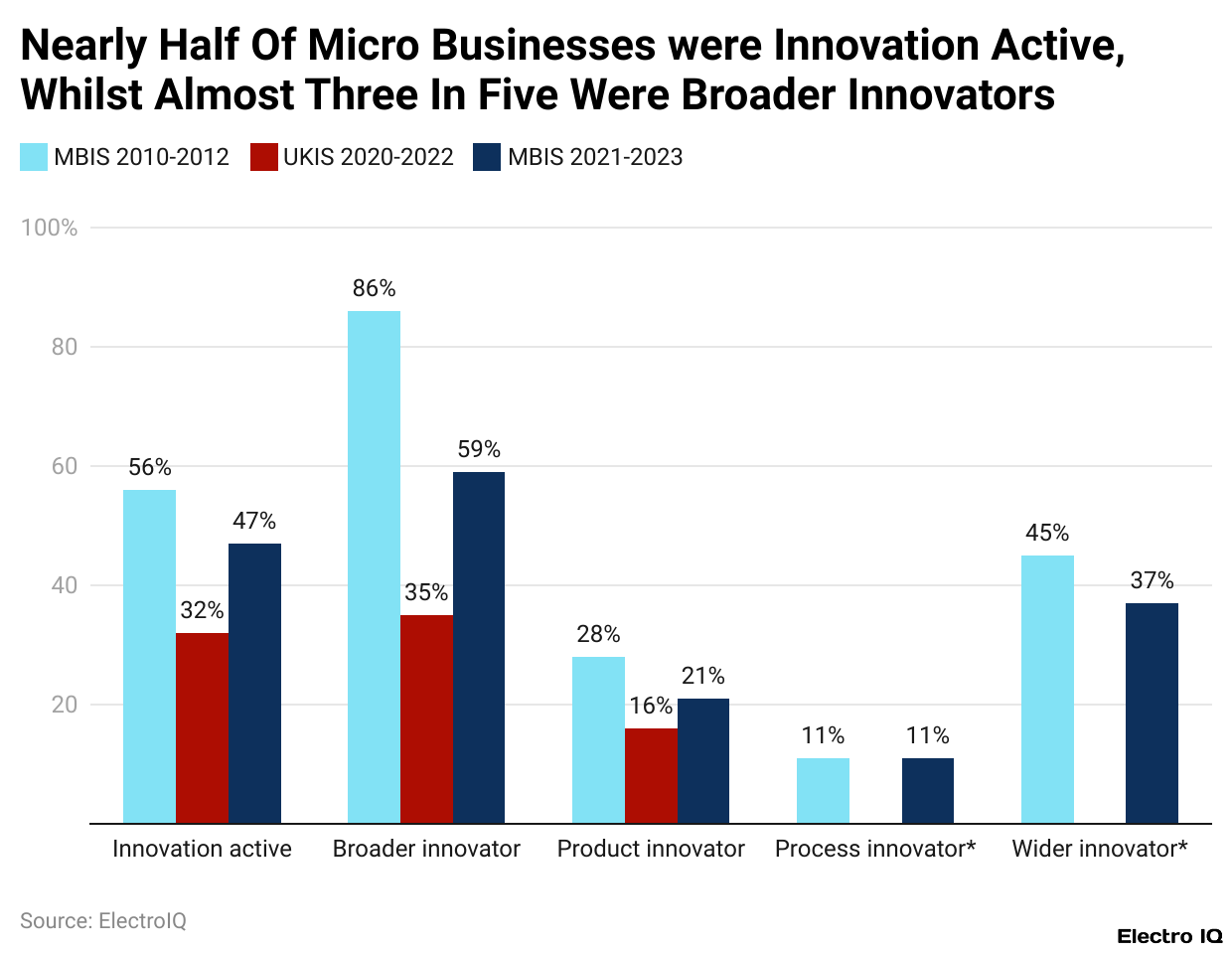
(Reference: economy-ni.gov.uk)
- As per Economy-ni, Business innovations statistics state that during recent years, micro-enterprises have been on the decline in different types of innovation activities, compared to 2014. Namely, 47% of micro businesses were innovatively active according to the recent data, whereas in 2014, it was 56%.
- The percentages for wider innovators were 59% and 86%, respectively, while for wider innovators were 37% and 45%.
- Product innovation also declined, with 21% of micro businesses innovating in products or introducing significantly improved products, in contrast to 28% in 2014. Conversely, process innovation remained stable at 11%, the same level as in 2014.
- Still, according to the UK Innovation Survey (UKIS) 2023, micro businesses have shown better entrepreneurial activity, broader innovation, and product innovation than any other firm, small to large.
Business Innovation By Sector
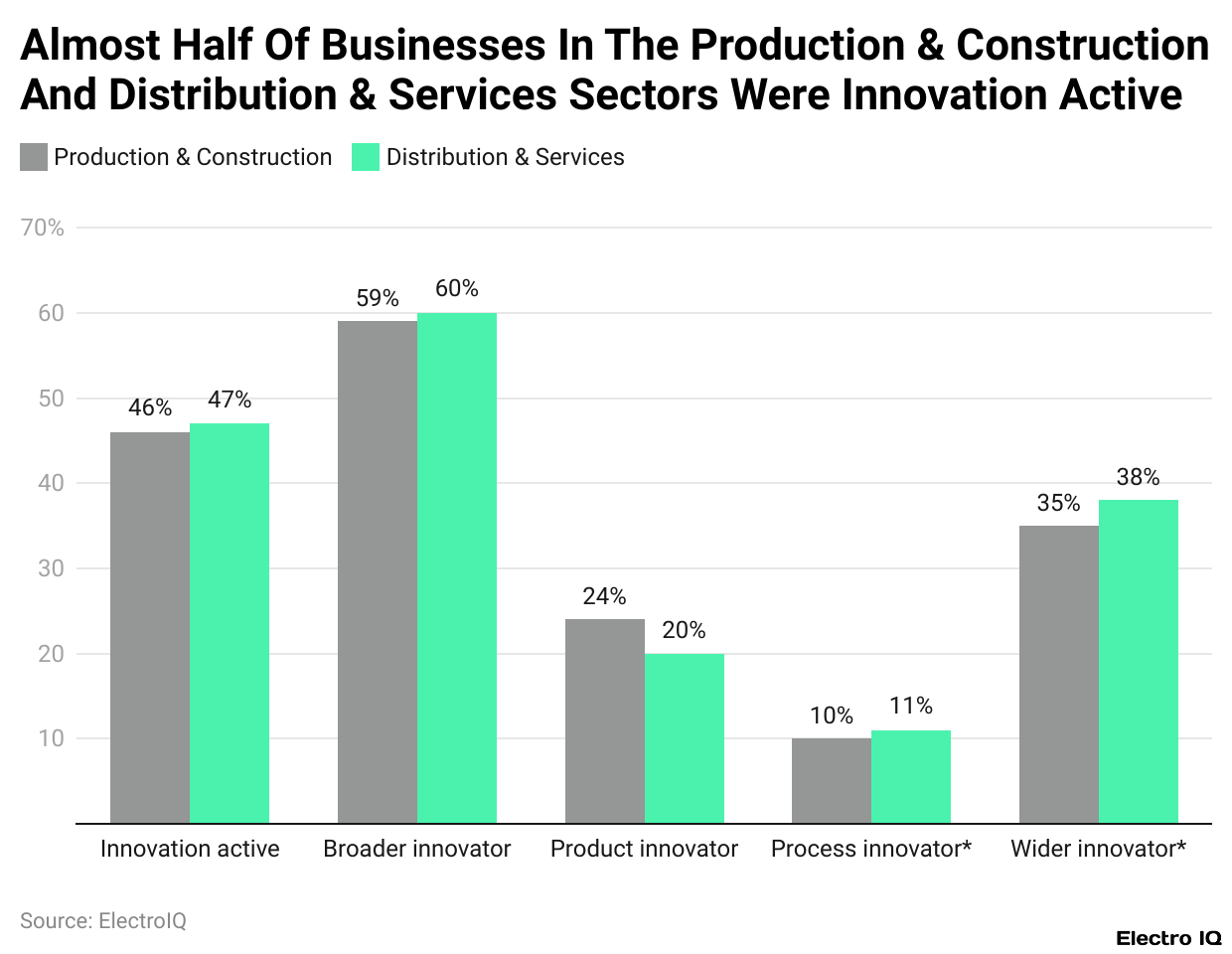
(Reference: economy-ni.gov.uk)
- The data bring out trends in innovation activity for micro businesses between two primary industry groups: Production & Construction and Distribution & Services.
- In the Production & Construction sector, which includes mining, manufacturing, chemicals, and construction-46% of micro businesses were identified as being innovation active, while 59% were considered broader innovators.
- These figures very closely resemble those found in the Distribution & Services sector, where 47% were innovation-active businesses while 60% were larger innovators. This shows relatively constant levels of activity-engagement innovation across the two sectors.
- However, when the data are compared to the 2014 figures, some declines are for sure visible, mainly in services and distribution: the broader innovators have fallen from 88% to 60%, while activities innovators dropped from 84% to 33%; the percentages of innovation-active businesses fell from 58% to 47%, and wider innovators went from 47% to 38%.
- Going one step further into specific industries reveals big declines in broader innovation for some of the industries.
- Wider innovators in Construction scaled back rather sharply from 83% to 58%; wholesale traders, including those in cars and bikes, fell from 91% to 63%; better-grade retail traders, excluding vehicle sales, from 76% to 59%.
- Even worse was the drop in innovation in Transport, storage, and communication, beginning at 89% and ending at just 30%.
- Meanwhile, hotels and restaurants saw a huge drop from 80% in 2014 to 54% in 2024. Because industries, apart from these two, had smaller sample sizes, the report cautions against drawing any conclusions when comparing data for 2014 and 2024.
- One may say data points to innovation activity in micro businesses trending down in the past decade.
Impact of Business Innovation
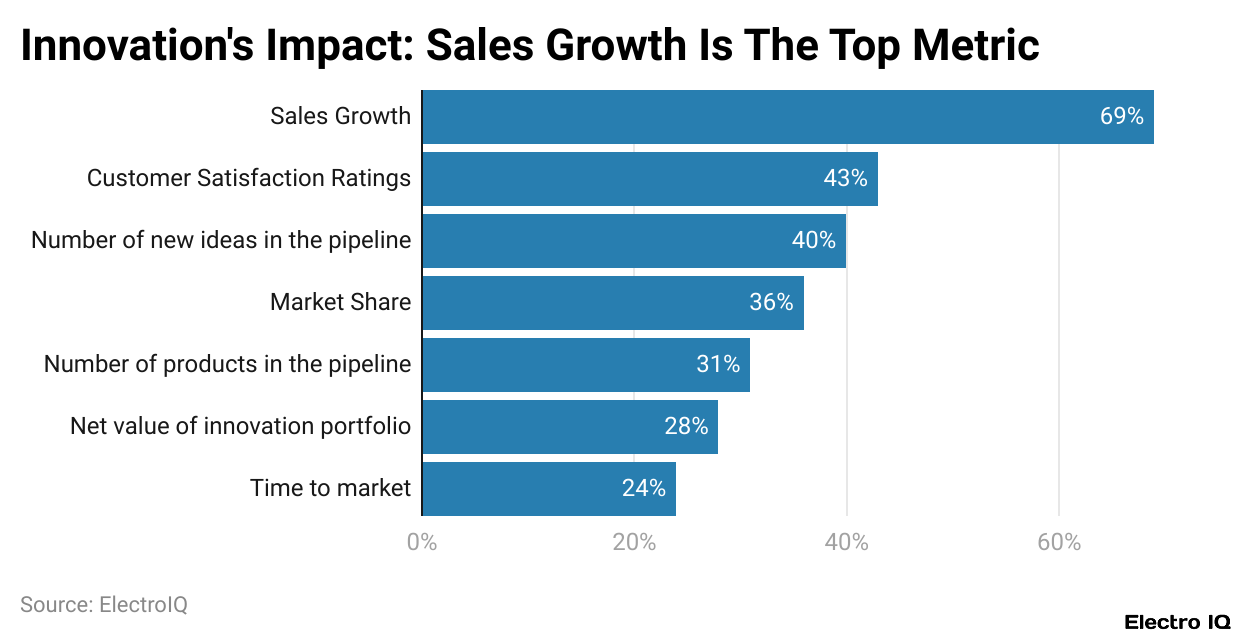
(Reference: businessdasher.com)
- As per Businessdasher, Business innovations statistics show that companies tend to evaluate the results or impact of their innovation by all sorts of specific measurements.
- Growth in sales is most commonly used. Almost 69% of firms say sales growth is the main criterion for successful innovation.
- Customer satisfaction also ranks high, with 43% of firms considering it among the top measurements for assessing innovation results.
- The emergence of new ideas is another, with 40% considering the number of new ideas yet to be implemented as a crucial measure of innovation health.
- On the other hand, 36% consider changes in market share as a crucial measure for indicating that innovations are effective and help the company compete.
- Furthermore, 31% of companies track their innovations based on the number of products they currently have in the development stage.
- Finally, 28% of companies estimate the net value of their innovation portfolio to gain insights into the overall financial impact of their innovation programs.
- Meanwhile, 24% still value time to market as a key indicator for innovation, from how fast a new idea can be developed into a product or service. These metrics epitomise a balanced portfolio consisting of financial, operational, and customer perspectives.
Barriers to Business Innovations
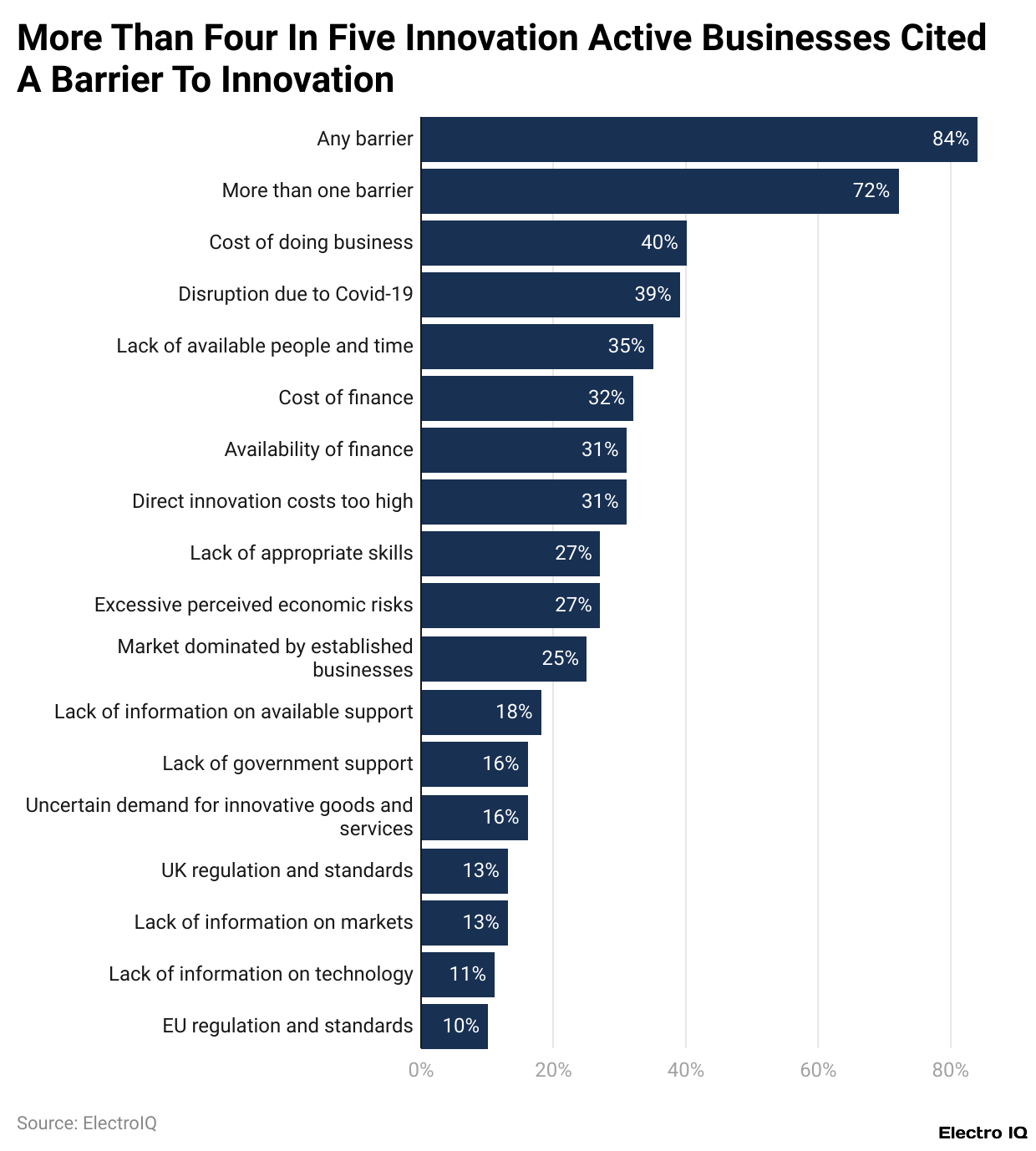
(Reference: economy-ni.gov.uk)
- 84% of innovation-active micro businesses have declared that they were confronted with at least one barrier to innovation, with 72% claiming they face more than one challenge.
- The general cost of doing business was by far the most cited issue, affecting 40% of the respondents.
- It was followed closely by the disruption induced by the COVID-19 pandemic, which hit 39% of the innovation-active micro firms.
- Another widespread barrier cited was the lack of available personnel and time, at 35%. Financial impediments also constituted a close second group.
- Those responses indicate that a heavy impact of financial and structural issues continues to limit micro innovation capacities.
- These responses highlight that both financial and structural challenges continue to significantly affect micro businesses’ capacity to innovate.
Business Innovation Blockers
- Certain challenges get in the way of the company’s ability to innovate successfully. Long development times are cited by 42% of companies as a significant hindrance to the success of innovations.
- Such delays do slow down the entire process of innovation and diminish its competitiveness.
- Identifying the right ideas to pursue is another frequent challenge, with 32% of companies having difficulty deciding which inventions deserve development.
- Additionally, a risk-averse culture inside an organisation was cited by 31% of companies as a barrier, wherein the fear of failure blocks projects or ideas from advancing.
- Coordination also matters for innovation; 25% of companies complain that the lack of collaboration or alignment among teams impairs their innovation efforts.
- Another 22% say they don’t have enough great ideas in their pipeline, pointing to idea generation itself being a limiting factor.
- Last but not least, 20% of companies put the difficulty of marketing their innovations as a key barrier that shows how even perfect ideas can go south if not communicated or positioned effectively in the marketplace.
- These figures stress the need for smooth processes, cultural support, and strong marketing to further innovation.
Business Innovation By AI Adoption And Investment
- As per Wifitalents, Business innovation statistics indicate that 61% of organisations have implemented AI in at least one area of their operations.
- 96% of top performers are either currently investing in AI or will invest in it within the next year.
- 60% of businesses are using AI for predictive analytics.
- 53% plan to scale up investments in AI during 2023.
- 80% of the data companies will generate will undergo processing using AI tools by 2025.
- 50% of organisations utilise AI for fraud detection and security enhancement.
- 72% of enterprises have employed some type of automation where AI is involved.
- 62% talk about being able to process lots of data through AI.
- 59% of organisations think that innovation strongly depends on AI.
- In retail, 85% of organisations use AI to personalise experiences and recommendations.
- 75% of financial institutions rely on AI for credit scoring and risk evaluation.
- 36% of small and medium businesses plan to activate AI within the next year.
- 85% of HR departments will be applying AI-enabled tools in order to facilitate the recruitment process.
- 55% of organisations use AI to figure out customer behaviour and market segmentation more accurately.
- 58% say their objective is to use AI to make real-time business decisions.
- Despite the growing adoption, 75% of AI projects fail to realize an expected ROI, implying implementation-related issues.
- 54% of businesses give attention to the ethical, responsible use of AI, including the vision of a governance framework.
- 82% of business leaders, up from 37% last year, consider AI a strategic imperative for digital transformation.
- 53% of companies are looking into AI-powered autonomous systems, including drones and robots, for operational tasks.
- 77% of marketers already use AI to run targeted, personalised ad campaigns.
- 45% of businesses said they are finding it difficult to integrate AI into their existing IT organisation and infrastructure.
- 66% consider AI an important part of their cybersecurity approach.
- Visibility and traceability in their supply chains 57% are assisted by AI; in a digital innovation strategy, 69% consider AI as its core.
- AI tools are used in fraud detection systems in 72% of finance firms. Creativity counts for 55% in AI-based automatic content generation systems.
- A majority of 76% chief data officers see AI as critical to data management and governance.
Conclusion
Business innovation in 2024 is backed by immense investments, rich technological advancements, and a strong emphasis on sustainability. Innovating companies yield tremendous returns in terms of profit, increased customer satisfaction, and operational efficiency. However, one must be cognizant of lingering challenges such as scarcity of resources, weak strategies, and inability to collaborate.
To ever stand in competition, organisations will be forever investing in innovation, have a culture that supports creative thinking, and espouse structured strategies that are in tandem with their long-term aspirations.
Sources
FAQ.
In 2024, 47% of micro businesses were active innovators in comparison to 56% in 2014. Product innovation rate decreased from 28% to 21%, while process innovation largely remained at 11%. Despite this, micro companies prove far better than large organisations in terms of broader and product innovation.
The biggest drop in wider innovation was visible in the Distribution & Services sector, which saw its level decline from 88% in 2014 to 60% in 2024. A big drop was seen in wider innovation in transport, storage, and communications, from 89% to 30%, while hundreds of establishments opened under the hotel and restaurant industry, to the tune of 80% to 54%.
A whopping 84% of micro businesses active in innovation claimed there is at least one barrier, with 72% reporting multiple barriers. The main barriers consist of financial obstacles (e.g., cost of finance and high innovation costs), lack of personnel, poor coordination, and risk-averse culture. Long development times and difficulty in idea selection are among other hindrances to innovation.
Its adoption with wider reach has seen 61% of businesses using AI in at least one of their processes, with 96% of leading businesses actively investing in this domain. AI facilitates predictive analytics, customer behaviour analysis, fraud detection, and real-time decisions. With all that adoption, 75% of AI projects fail to meet ROI expectations, mainly because of failures of integration and strategy.
The most popular indicators of innovation success revolve around sales growth (69%), customer satisfaction (43%), and the capacity for new idea generation (40%). Changes in market share, products in development, time to market, and innovation portfolio value make for others balancing innovation in financial, operational, and customer terms.

Maitrayee Dey has a background in Electrical Engineering and has worked in various technical roles before transitioning to writing. Specializing in technology and Artificial Intelligence, she has served as an Academic Research Analyst and Freelance Writer, particularly focusing on education and healthcare in Australia. Maitrayee's lifelong passions for writing and painting led her to pursue a full-time writing career. She is also the creator of a cooking YouTube channel, where she shares her culinary adventures. At Smartphone Thoughts, Maitrayee brings her expertise in technology to provide in-depth smartphone reviews and app-related statistics, making complex topics easy to understand for all readers.






